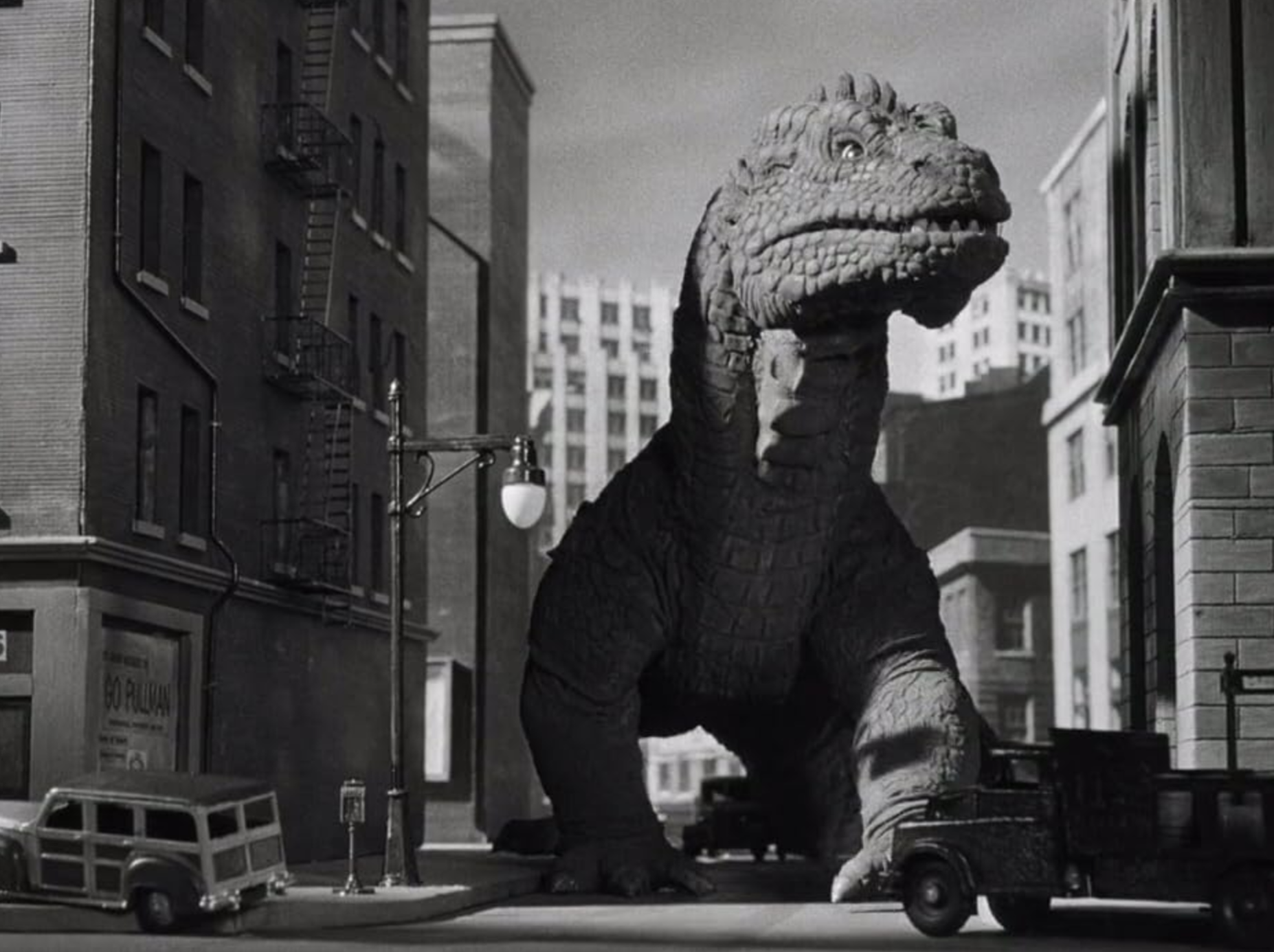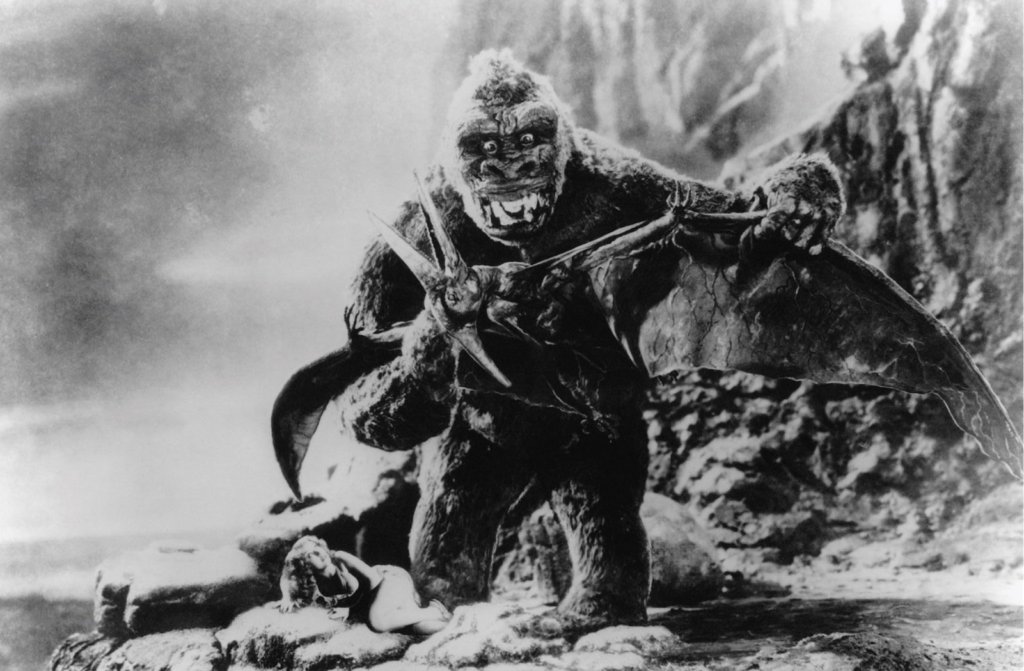Monster movies, we love them, but there is a sub-genre of these films that rarely gets any attention, paleo-fiction. So, let’s review the top ten horror movies steeped in the science of paleontology.
#1 KING KONG
Director: Merian C. Cooper and Ernest B. Schoedsack
1933s King Kong has been ranked by Rotten Tomatoes as the greatest horror film of all time, and who could argue with that? The story was inspired by the popular jungle films of the day like Tarzan, as well as the movie many of those who created Kong’s amazing effects had worked on previously, The Lost World. Kong was something new, however. In a film full of dastardly prehistoric monsters its main protagonist was a sympathetic creature that the audience truly connected with. Created by Willis O’Brien, the film’s special effects were groundbreaking, taking the art of stop-motion to a whole new level and setting such a high-water mark that it would not take years, but decades before they were surpassed.
King Kong’s dinosaurs were inspired by the world-famous paintings by Charles R Knight at the American Museum of Natural History. Sadly, when the movie was re-released years later the far stricter rules about movie violence meant many of these scenes were cut by the heavy-handed censors of the day.
Kong’s great success spawned sequels, comics, remakes and inspired numerous imitators, but none have ever surpassed the magic of the original.
#2 THE BEAST FROM 20,000 FATHOMS/ THE GIANT BEHEMOTH

Director: Eugène Lourié
It took two decades for the next major prehistoric monster to appear, and this one was created by an apprentice of Willis O’Brien. Ray Harryhausen’s ‘The Beast from 20,000 Fathoms’ created a sub-genre all of its own, the ‘science vs the monster of the week’ that would dominate so many horror films of the 50’s and 60’s. Based on Ray Bradbury’s short story ‘The Fog Horn’, the ‘beast’ was a Rhedosaurus, a 200ft stop-motion dinosaur that was released from its icy hibernation in the Arctic by an atomic bomb explosion and headed south. One survivor of its initial appearance teams up with a paleontologist – who speculates the monster is returning to the Hudson Bay area as this is the exact spot that Rhedosaurus fossils have been unearthed.
Lourié followed his hit with ‘The Giant Behemoth (1959)’, which was totally different to his earlier film. In this an aquatic monster became saturated by nuclear waste, and later travelled south to take out its angst on London. It was a paleontologist who recognized the behemoth was actually a dinosaur, which he named Paleosaurus.
These films can be seen as a reflection of their paranoid tainted times. In a world where the US and Russia were seemingly threatening all of humanity with nuclear annihilation, is it any wonder that people sought refuge from the horror of their daily lives by watching the destruction of atomic monsters on the silver screen?
The Beast from 20,000 Fathoms was the first movie to use atomic energy to create a monster in this way, and Harryhausen’s creature would become the main inspiration for what has arguably become the most famous atomic prehistoric monster ever put on film.
#3 GODZILLA (Gojira)

Director: Ishirō Honda
Now to be fair the origins of Godzilla have changed many times, and though not considered a dinosaur in some films, it was always either a prehistoric creature or forged in atomic fires. When the original Godzilla was being designed by the movie’s art director, Akira Watanabe, he based it on the old-style T. rex, Iguanodon and Stegosaurus that he saw in LIFE magazine at the time, as well as an alligator (all of which you can clearly see in its form).
No one could have guessed the impact Godzilla would have on the world in 1954, with dozens of movies, followed by cartoons, comics, toys and t-shirts filling the childhood of millions of fans for over half a century – and with the recent success of 2014s Godzilla and a sequel on the horizon, this movie monster shows no signs of going extinct anytime soon.
#4 THE DEADLY MANTIS

Director: Nathan H. Juran
With the success of these earlier films atomic creatures became all the rage, with animals either spawned out of the energy of a fission bomb or being released from their icy prisons. Two years after Godzilla stomped Tokyo the world fell under the terrifying grip of The Deadly Mantis – a 200ft prehistoric insect released from its artic prison, which of course immediately headed south towards a major city. When a strange object is found in its empty ice cocoon and shown to a paleontologist, he recognizes it as a piece of leg from an enormous extinct praying mantis.
#5 QUATERMASS AND THE PIT
Director: Roy Ward Baker
Known as Five Million Years to Earth in the US, Quatermass and the Pit (and its ‘hero’ Professor Quatermass) can be viewed as coming from the same mold as Dr Who or A.C. Doyle’s Professor Challenger. This British series has appeared in movies, TV shows, books and comics, and is about a scientific hero who steps into strange incidences and tries to explain and solve them.
Quatermass and the Pit is the flagship story of the entire group as its been remade in most formats, and all are pretty good. The story begins with a tunnel being dug under a place called Hobs End, with the workers uncovering a number of Neanderthal skulls. This brings in a team of paleontologists, who begin collecting the skulls only to discover a mysterious metal object buried with them. They then return to their institute to preserve and do tests on the fossils, and in the 1967 version you see one wacky version of a triceratops skeleton out the front.
Thought to be the remains of a German rocket from the war, tests on the metal prove its of alien origin, and once the army and scientists break in they discover the dead bodies of the crew, and now exposed to the air these insectoid creatures immediately start to rot.
But just because their bodies are dead does not end the danger these aliens present. After theorizing the aliens had encouraged human evolution, mysterious deaths begin to mount up around the ship and Quatermass deduces the ship itself is alive and taking over people’s minds with telekinesis.
If you like Dr Who (and even if you don’t) the Quatermass series is pretty great and Quatermass and the Pit is a creepy, horror filled suspense story well worth a watch.
#6 THE CREATURE FROM THE BLACK LAGOON

Director: Jack Arnold
Universal, famous for its classic horror films like Dracula and Frankenstein, also made an entry into the paleo-fiction genre with what is likely the smartest, best filmed horror of the 50s. ‘The Creature From the Black Lagoon’ begins with a paleontologist uncovering a fossil webbed hand in limestone dating back to the Devonian Age. This leads to a new expedition into the Amazon to try and unearth the rest of the fossil, but what they find instead is DEATHHHHHhhhhhhhhhhh….
Not only does the movie contain one of the now classic Universal Monsters, it’s full of paleo-jargon, with characters discussing extinction, geology and how life evolved. Designed to be seen in 3D, the film is remembered for its fantastic underwater scenes, with the creature – a piscine amphibious humanoid that evolved from this Devonian species – swimming alongside or directly under expedition members.
The Gill-man itself is also notable as being the only classic movie monster designed by a woman. Sadly Disney animator Milicent Patrick’s role in creating the creature was deliberately hidden in later interviews, but today she is recognized for her amazing work.
#7 THE THING (also The Thing From Another World)
Director: Howard Hawks (1951), John Carpenter (1982), Matthijs van Heijningen Jr. (2011)
Prehistoric creatures fell out of favor for a lot of years after these earlier films as horror movies turned away from monsters to more psychological/slasher thrillers like Psycho, the Omen and Halloween…but they were not done with just yet. Movie monsters are often created to help reflect society at the time, and soon a new terror was killing people by the thousands in the real world, an enemy hidden within ourselves. The paranoia and fear created by the AIDs epidemic of the early 80s cannot be downplayed, and John Carpenter’s ‘The Thing’ would take that fear and run with it. A remake of the 1951 Howard Hawks masterpiece, ‘The Thing From Another World’, Carpenter took the world on a paranoid filled horror, one where your own blood could be turned against you.
Released onto a viewing public that saw aliens as misunderstood, loveable scamps thanks to films like ‘ET’ and ‘Close Encounters’, it’s fair to say that despite being incredibly well-made ‘The Thing’ initially never found an audience. “Is this the most hated movie of all time?” is how one journal titled its review of the 1982 film, with almost every movie critic at the time agreeing the picture was one of the worst films ever made. Though despised by critics ‘The Thing’ did find an audience, albeit a small but incredibly dedicated one, and today it’s considered one of the best horrors ever filmed.
In 2011 a prequel to Carpenter’s film was released, where once again a paleontologist is called in to investigate something ancient trapped in polar ice. Just like the plot line, history also repeated itself as once more this version initially failed to find its audience, though as time passes a growing fan base seems to be appreciating what the film attempted to achieve.
There is a heavy science basis in all three films – with many of the characters having a scientific background – leading to an overall theme of evolution. The creature in these films is just looking to survive, and be it a human in a monster suit, an enormous, intricately made puppet or a CGI version, this is the premise running through all these stories. The way the alien evolves, adapts and overcomes to get off Antarctica and reach the rest of the world leads to the self-realization with those fighting the creature that, though the individual may not survive, the species must. In this humanity is revealed to be different from the alien as it is the humans that understand the whole is more important than the part and many choose to sacrifice themselves to save everyone else. For the Thing, each part, right down to its individual cells, is out to survive in anyway it can.
#8 THE THAW

Director: Mark A. Lewis
‘The Thing’ has its own emulators as well, with similar storylines appearing in the X-files and most recently in ‘The Thaw’. This 2009 movie also taps into another fear at the moment, climate change, and deals with dead frozen mammoths thawing out of the polar ice and releasing ancient pathogens on the world. Though unloved by just about everyone, its still worth a watch for its paleontology and scientific themes.
#9 THE LOST WORLD: Jurassic Park/CARNOSAUR
Director: Steven Spielberg/Adam Simon
By far the most successful paleo-fiction films are from the Jurassic Park franchise, and 1997s ‘The Lost World’ should be firmly placed in the classic Hollywood horror genre. The end of the film is even a tip-of-the-hat to many of these older films, with a monster cut loose in the streets of a big city. The other thing the sequel does is up the body count and scares, with the film a smorgasbord of people getting chomped and stomped, and there are some genuinely spooky scenes (such as the raptors sprinting through the long grass or the T. rex sniffing the bloody shirt inside a tent).
Just like King Kong years earlier, this franchise has inspired numerous imitators, though 1993s ‘Carnosaur’ should not be considered one of them. Based on the book by John Brosnan, this was published well before Crichton’s Jurassic Park novel so cannot be considered a clone…because, you know, all the JP dinosaurs are clones. Carnosaur is about a mad scientist who decides to use genetics (and chicken DNA) to bring dinosaurs back to life so that they will destroy the world.
#10 LAKE PLACID

Director: Steve Miner
Writer: David E. Kelley
At the start of the 21st century there was no larger TV producer than David E. Kelley. Having produced mega-hits like L.A. Law, Picket Fences, Chicago Hope, The Practice and Ally McBeal, Kelley wanted to try his hand at the big screen.
In a large lake in Maine a marine fish and game officer is killed by something living under its dark waters, and when the body is investigated an enormous shed tooth is found. Big enough to be a dinosaurs’, the American Museum of Natural History paleontology department sends a representative out to join a Fish and Game investigation to find out the killer’s identity. Hi-jinx ensue, along with many heads flung about as the team encounters an enormous croc.
The Lake Placid series is a return to the idea of nature run amok, and it joined a growing list of films with giant creatures attacking modern civilization. Recently our movie screens have been filled with more traditional monsters, such as the giant Kaijus in Pacific Rim, even larger dinosaurs and even a prehistoric shark called Megalodon. With the latest Jurassic World movie far more of a horror than a paleontology based sci-fi, with a MEG sequel due next year, along with new Godzilla films on the way it would seem the world is not done with prehistoric cinema monsters just yet.
The above article was written by Phil Hore. Phil Hore has written for newspapers and magazines across the globe, and has worked as an educator at the Smithsonian, the Field Museum and the Australian War Memorial. He writes history, science and science fiction, and often finds all three meeting each other on the page


